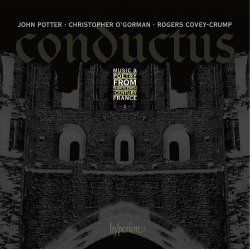| 
|
Conductus II - Music and Poetry from thirteenth
century France
Bulla fulminante (unmeasured) [3.13]
Ave, virga decoris incliti [3.02]
Celorum porta [3.51]
Quid ultra tibi facere [4.15]
Gaude virgo virginum [5.51]
Veste nuptial (unmeasured) [1.49]
Ave tuos benedic - two part [2.46]
Ave Maria salus hominum [3.01]
Dic Christi veritas (monody) [2.28]
Ave tuos benedic - three part [3.12]
Excutere de pulvere [3.58]
Librum clausum et signatum [5.27]
Aurelianis civitas [3.01]
Dic, Christi veritas (three part) [6.57]
Veste nuptial (measured) [2.27]
Bulla fulminante (measured) [2.18]
John Potter, Christopher O’Gorman, Rogers Covey-Crump (tenors)
rec. National Centre for Early Music, St. Margaret’s Church, Walmgate, York, 16-18 January 2013
HYPERION CDA67998 [70.45]
This is the middle release of a series of three discs announced as being made under the auspices of the University of Southampton. It has been sponsored as part of a bigger research project by the ‘Arts and Humanities Research Council’. The aim is to look in detail into the artistic culture of the 13th century. All three discs concentrate on a form of mainly vocal music called the conductus. It’s an area of study which has been a little overlooked in favour of the motet and chansons of the early medieval period.
The three ‘medieval’ singing tenors, as it were, are all experienced and expert in this area. They sang together for volume 1 (Hyperion CDA67949) and have been recording separately for many years. Mark Everist who writes the fascinating and clearly written booklet notes is a leading scholar in the repertoire.
First what is a conductus? These can be monodic. It’s interesting how memorable the tunes are when exposed alone (Vesti Nuptial - Track 15) in two, three or occasionally four parts - although obviously none are heard here. They move, in a generally uniform rhythm which is therefore contrary to motets and organa. They mainly date from the 13th century and are all anonymous. They were not for liturgical use and so do not use plainchant. Conductus are in Latin but not all parts have the text. This has led in older recordings to instrumental participation where text was omitted. Since the pieces are notated in score and the parts move in the same rhythm it would surely have been unnecessary to copy the words out for each. It was common at the end of lines or stanzas and sometimes also at the beginning of lines (Librum clausum et signatum) for the parts to break out into melismas and hoquets. These were sung mostly to a vowel sound. These melismas or caudae could then take on a life of their own and be enlarged sometimes into dance melodies or songs. Everist’s booklet notes explain this in fuller detail and all texts are provided and excellently translated.
The texts, poetry in fact, seem now to be very obscure and often political. Some commemorate special events, for example the martyrdom of St. Thomas a Becket (Novus miles sequitur - not recorded here) or the consecration of a basilica or a violent riot in Orléans as in Aurelianus civitas.
Differing versions of some pieces, from various manuscripts found throughout Europe, are given either in two and then later in three parts. Some of these appear as monodies and then in parts. Some monodies are offered in measured and then unmeasured versions.
This leads us neatly on to another question. This concerns the rhythm that should be adopted. It’s not really notated in the manuscripts. This is quite a contentious issue but it has been common to perform conducti in the triple time associated with the perfectum signatures in the originals. This practice was adopted in recordings by groups like David Munrow’s Early Music Consort and in the early recordings by Gothic Voices. In the last two decades the use of free rhythm has been more common. In this recording the two cross-fertilise brilliantly - no doubt after much rehearsal and discussion. The result is that often the melismas are in measured time and the texted section in unmeasured, as indicated on the CD listings on the back of the booklet. In the mid-1990s Red Byrd of which John Potter was a leading light, recorded (Hyperion CDA66944, now CDH55328; also CDA67289, now CDH55338) sacred music by Léonin, though from an earlier generation than the conducti recorded here, in just this way.
There is a certain amount of fashion involved in the presentation of early medieval music. Scholarship will no doubt move on again but if this repertoire interests you then you will find this disc and its earlier companion fascinating and evocative.
One can also add without hesitation that the singers cannot, at present at least, be bettered. The recording was made in the 12th century church of St. Margaret Walmgate which is York’s Early Music Centre. Although close, it is totally clear and reliable.
Gary Higginson
 |
 |
|
